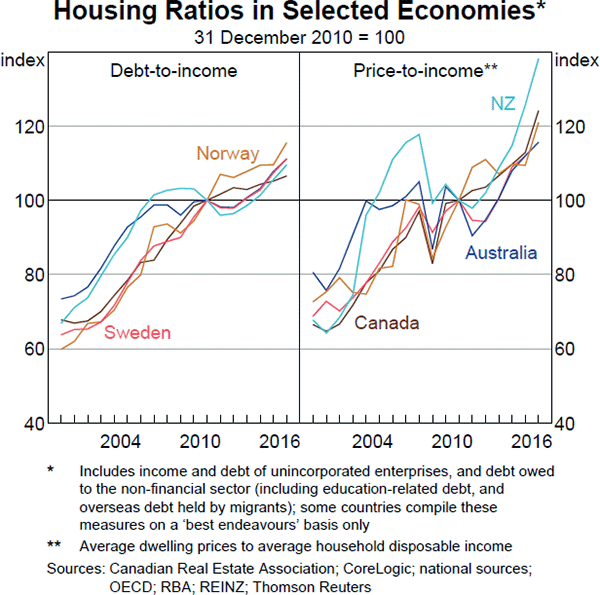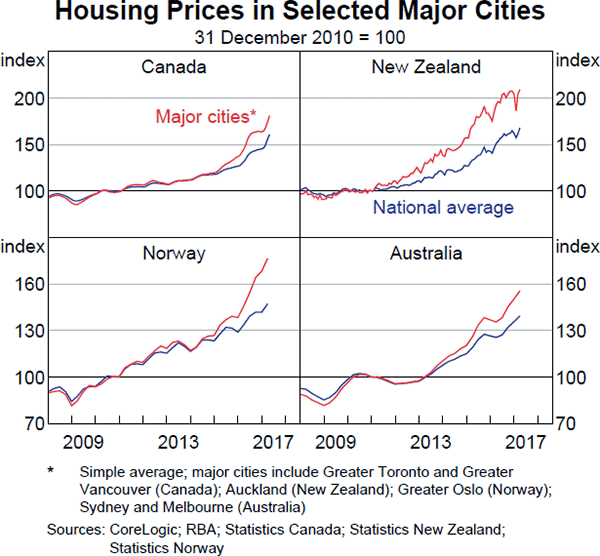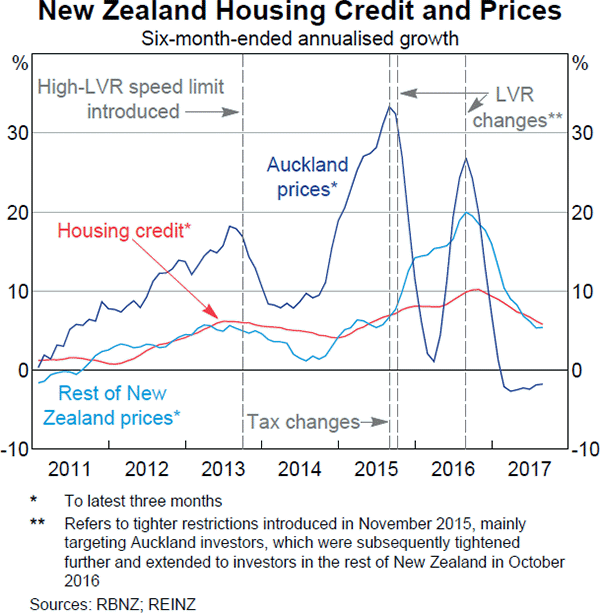Financial Stability Review – October 2017 Box A: Risks in International Housing Markets
Housing debt in a number of countries has risen from already high levels in recent years and has coincided with some evidence of riskier lending and strong growth in housing prices. This has raised concerns about the resilience of households and banks to negative shocks, particularly as interest rates start to rise from very low levels. This box outlines: recent developments in the housing markets of Canada, New Zealand, Norway and Sweden; key risks associated with these developments; and recent policy actions to address these risks.
Recent Developments in International Housing Markets
Housing debt and prices in these four small open economies have been rising from already high levels, outpacing growth in incomes and rents (Graph A1). As in Australia, much of the recent housing price growth has been concentrated in major cities, while smaller cities and rural regions have generally experienced much slower price growth or in some cases price declines (Graph A2).


Housing prices have been boosted by an increase in demand and constrained supply. On the demand side, low interest rates have enabled households to borrow more to purchase housing. In some major cities, strong population growth and heightened investor activity have also increased demand for housing. Housing supply generally has not risen to the same extent as demand due to the usual constraints of lags in planning, approval and construction. Building new housing in major cities can face more serious constraints because of restrictions on the availability of land, including natural barriers and zoning requirements. Rent controls and the scaling back of some social home-building programs have also played a role in constraining supply in some cities.
Key Vulnerabilities
Authorities in the affected countries have expressed concern that high, and rising, household debt relative to income, together with riskier lending, has likely made households less resilient to negative shocks. At the same time, there is concern that the rapid increase in housing prices has increased the risk of a subsequent sharp price fall, particularly if it has been partly driven by speculation. Taken together, these developments have increased the risk of financial and macroeconomic instability.
While household debt levels are high, and rising, to date the impact on households' ability to service their debt has been muted by falls in interest rates to historically low levels. Nonetheless, highly indebted households are more likely to struggle to repay their debts, or substantially reduce their consumption, in response to a negative shock, such as a rise in unemployment, an unexpectedly large increase in interest rates or a sharp fall in housing prices.[1] This could lead to bank losses and slower economic growth. Banks in turn might be less able or willing to provide credit to the economy, amplifying any downturn.
The distribution of debt is also important in identifying where risks lie as typically it is not the ‘average’ household that gets into financial difficulties. In Canada and Sweden, for example, the risks from high household debt may be heightened since the debt is concentrated among younger and low-to-middle-income households, who are likely to be more vulnerable to negative shocks.[2]
As in Australia, national authorities have also been concerned about riskier lending, which can further increase vulnerabilities.[3] For instance, lending at high loan-to-valuation ratios (LVRs) has worried regulators in many countries, in part because households that borrow at high LVRs are more likely to fall into negative equity if housing prices decline. In this scenario, such households would be unable to repay their debts by selling their homes or to cushion income falls by drawing down on equity. Increasingly, regulators are turning their attention to loans that are large relative to borrowers' income. Such loans could stretch the ability of households to repay their debts and make them more sensitive to falls in income or unexpected rises in interest rates. Further, interest-only (IO) lending has been identified as increasing risks in some jurisdictions.[4] Households with IO loans remain more indebted throughout the life of the loan than if they had been paying down the loan principal, making them more vulnerable to higher interest rates, reduced income, or lower housing prices. Such households are also more vulnerable to ‘payment shock’ due to the increase in repayments following the end of the interest-only period of the loan.
Much like in Australia's largest cities, investor demand has been strong in several fast-growing markets, including Auckland, Toronto and Vancouver. Rapidly rising prices and low rental yields suggest that this demand is at least partly based on expectations of capital gains. If speculation has played a role, this can raise the risk of housing price falls in the future. Past episodes in several countries also suggest that investors may be more likely than owner-occupiers to sell their properties in a downturn or default on their loans in times of stress, posing risks to the broader market and the banking system.[5] In some markets, such as Toronto and Vancouver, foreign investor activity has boosted demand for housing, contributing to the upswing in some segments of the market. It is uncertain how foreign investors will behave in a downturn.
Macroprudential Policy Responses
Low interest rates, which central banks view as appropriate given their inflation and output or employment objectives, have contributed to the run-up in housing debt and prices in many economies. National authorities have, therefore, been increasingly using macroprudential policies to address the associated risks.
Foreign authorities' macroprudential policies have focused on three key areas:
- Households' equity buffers have been strengthened by the use of tighter LVR restrictions – often specifically targeting investors – to lower the proportionate amount households can borrow (such as in Canada and New Zealand). IO lending has also been restrained by the implementation of minimum amortisation requirements for loans at high LVRs (in Norway and Sweden), which ensure faster repayment of mortgage debts and an associated build-up in equity.[6]
- Loan serviceability has been strengthened by imposing maximum loan-to-income ratios (in Norway) and debt-service ratios, which cap the proportion of income that households can allocate to repaying their mortgage in determining maximum loan size (in Canada).[7] Banks in Canada and Norway are also required to check that households are able to service their debts if faced with significantly higher interest rates.
- Some regulators have increased the regulatory capital requirements by raising mortgage risk weights or increasing countercyclical capital buffers (as in Sweden). Regulators have also raised the minimum loss rate that banks can assume when setting aside capital against potential mortgage losses. These policies aim to boost bank resilience by raising capital reserves to cover potential losses in downturns.
It is difficult to assess the effectiveness of these measures and macroprudential policies more generally. These policies do not have a long track record; they often have differing objectives; and their effects are hard to isolate and measure, especially because they are often implemented in combination with other policies. National authorities have indicated that so far macroprudential policies have generally led to some improvement in household and banking sector resilience. For example, the share of high-LVR loans on banks' balance sheets has been falling in New Zealand. Macroprudential policies also appear to have contributed to slower growth in credit and housing prices, although experiences in countries such as New Zealand suggest that these effects tend to diminish over time (Graph A3). Some policies appear to have led to leakages and spillovers, such as avoidance behaviour, increased lending by less regulated institutions and a shift in price growth to smaller cities. However, these effects have been fairly limited so far.

Other Policy Responses
A number of authorities have also used other policy tools to mitigate housing market risks. Some governments have implemented tax policies to limit speculative activity. Provincial governments in Canada introduced higher taxes on investor purchases (particularly by foreign investors), and the New Zealand Government increased taxes on investor properties held for less than two years.[8]
Overall, available evidence suggests that a range of policies (including both macroprudential and other tools) have led to some improvement in household and banking sector resilience in several markets. However, household debt levels and housing prices remain high and continue to grow rapidly in many regions, so risks persist. Macroprudential policies can at best moderate the growth of credit and prices for a while, but they cannot address the high levels of debt and prices. Further, there continues to be much uncertainty around the calibration and effectiveness of these tools. Ongoing analysis and experience will be important for understanding the impact that such policies can have on housing market risks.
Footnotes
Academic studies find non-linearities in the consumption patterns of highly indebted households. See, for example, Mian A, K Rao and A Sufi (2013), ‘Household Balance Sheets, Consumption, and the Economic Slump’, The Quarterly Journal of Economics, 128(4), pp 1687–1726 and Bunn P and M Rostom (2014), ‘Household Debt and Spending’, Bank of England Quarterly Bulletin, Q3, pp 304–315. [1]
See Bank of Canada (2015), ‘Report on Indebted Households and Potential Vulnerabilities for the Canadian Financial System: A Microdata Analysis', Financial Stability Review, December, pp 49–58 and Ölcer D and P van Santen (2016), ‘The Indebtedness of Swedish Households: Update for 2016’, Sveriges Riksbank Economic Commentaries, November. [2]
See the ‘Household and Business Finances’ chapter for an assessment of housing-related vulnerabilities in Australia. [3]
For recent developments in IO lending in Australia, see the ‘Household and Business Finances’ chapter and APRA (2017), ‘Further Measures To Reinforce Sound Residential Mortgage Lending Practices’, Letter to Authorised Deposit-Taking Institutions, 31 March. [4]
See, for example, McCann F (2014), ‘Modelling Default Transitions in the UK Mortgage Market’, Central Bank of Ireland Research Technical Paper 18/RT/14 and Haughwout A et al (2011), ‘Real Estate Investors, the Leverage Cycle, and the Housing Market Crisis’, Federal Reserve Bank of New York Staff Reports No 514. [5]
Other countries, such as China and Singapore, have banned IO lending. [6]
A range of other jurisdictions have also introduced limits on loan-to-income ratios, such as the United Kingdom and Ireland, or caps on debt-service ratios, such as Hong Kong and the Netherlands. [7]
Similarly, both the New South Wales and Victorian governments have increased stamp duty for foreign housing purchasers and removed the deferral of stamp duty payments for some off-the-plan purchases. The New South Wales Government has also implemented an additional land tax for foreigner property owners, while the Victorian Government has imposed a tax on vacant residential land and an absentee owner surcharge. Governments in several other jurisdictions, such as Hong Kong and Singapore, have also introduced tax policies targeting speculative purchases. [8]